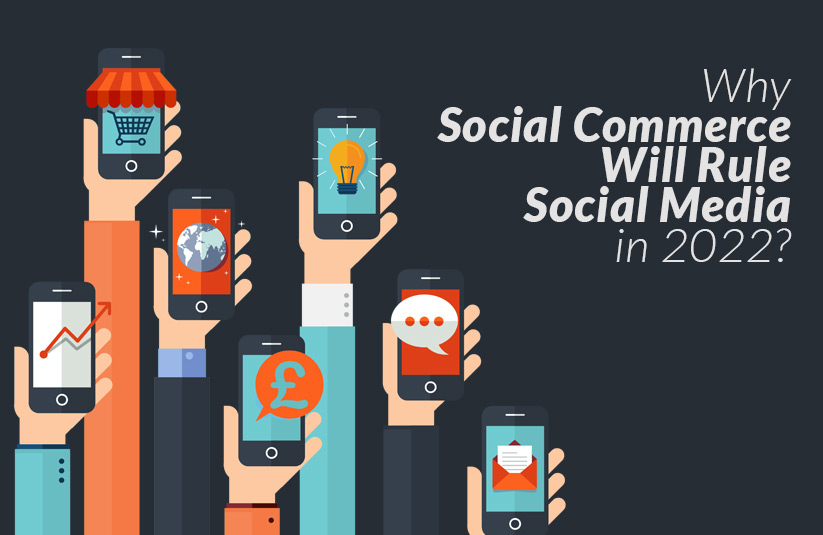Social Commerce Growth
Have you ever heard of the term “Social Commerce ”? Social Media and E-commerce used to work separately in the beginning age of the internet. Now, it has integrated to give birth to the term Social Commerce.
Social Commerce is the act of using the social media network to conduct business-related activities. Networking sites like Facebook, Instagram, Pinterest, TikTok, and Twitter are used as a vehicle to promote and sell various products and services. Companies measure customer interaction through the number of likes, shares, and retweets.
When companies give people the choice to look at their products and services and buy them as they surf through their social media, the audience will dive right into it. They need not go to a different site to search for something and compare its price range with multiple sites. All that burden is gone with the emergence of Social Commerce.
What is Social Commerce?
Social Commerce stands as the next best thing for brands to increase sales. It refers to a comfortable shopping experience for their customers through their social media platforms. Social commerce is revolutionizing e-commerce. Within the promotional posts, links will take the user directly to the purchasing point to the retailer’s website. It is that simple now.
The social media marketing skills You Need Right Now will help you cope with the resurgence of social media and the constant changing of the market. The market has fluctuated, that brands are reconsidering their marketing strategies and revisiting their customer service to be on top of the social commerce game. It is connected with social media as the brands drive the traffic from the social media platform to a website or online store.
Read Here: What is a Clubhouse and How Does It Work?
Social Commerce is making shopping online more user-friendly with chatbots and auto-fill payments. It also creates a more personal experience with a real-time suggestion based on your search history and likes. Brands use their social media platforms to gain votes for each of their products, offer promotions and giveaways, and celebrity endorsement of the product.
Customers become more attracted to the brands with the brightest and efficient marketing strategies. With more crowd attraction, people begin sharing the posts and ads with their friends, and it keeps on expanding.
Social Commerce Marketing Strategies and Trends
A single marketing strategy does not apply to every brand and situation. Social media users thrive on different marketing campaigns. However, basic marketing strategies use celebrities, influencers, user-generated content, giveaways, and consumer call to action.
Let us dig deep into different marketing strategies used by social media brands to enhance social commerce.
One of the best ways to promote your product or service is to adopt influencer marketing and promote it on different social media platforms. They can influence and encourage their community to purchase the product and expand the brand community. Platforms like Facebook gave influencers the ability to create shoppable posts.
Snapchat gave influencers a “shop” button with their stories. All posts and stories on different social media platforms will show whether it is sponsored or a partnership. This activity will boost brand traffic and customer engagement.
Catchphrases like “swipe up to purchase,” “link in the bio,” “tap to know more” have continuously grabbed the audiences’ attention. These calls-to-action phrases have become extremely popular, pushing social media users to ruffle through such posts and make a purchase.
User-generated content is up-and-coming in the social media market. Platforms like Instagram acts as the discovery engine for brands. Many small-scale businesses make use of this algorithm to reach a wider audience.
With TikTok videos, Reels, and Stories, the brand value increases with the number of reaches through likes, shares, and comments. Increased use of hashtags has also helped in promotions and crowd gathering. This viewer-friendly, visually centered content has become a boon for many brands and marketers.
Read Here: 6 Ridiculously Simple Ways To Boost Video Engagement
A Tailored personalized experience catches the eye of each buyer. Facebook and Instagram have featured customizable shops. It allows you to connect with any brand worldwide with a visual social storefront. With a customizable storefront, the brands can showcase their products more appealing with different collections and ranges.
Social Commerce is here to say. The broad reach and public support have proved that the audience is more inclined towards social commerce than regular online shopping these days. The common trends that have created an impact today include:
1. Live Streaming
A significant portion of today’s online content is in video format. It is the primary form through which brands catch up with a broader audience. Live streaming is a method by which company ambassadors promote the product or service, have a product demonstration, and discuss with their peers or audience.
Live streaming has become even more popular because it does not need any significant production value or set. A simple mobile phone with a camera will do the trick. Live streaming allows the audience to communicate with the brand employees and get to know the brand more as the company people interact with the live audience.
2. Intelligent Chatbots
One of the advantages of social commerce is instant messaging platforms like Instagram, Facebook, Twitter, Telegram, etc. Retailers can instantly interact with their audience and prospective buyers. As AI quality increases, companies use intelligent chatbots to handle overflowing customers as it reduces costs and increases sales. Chatbots can answer frequently asked queries without having humans stand by each message.
3. Improved Voice Technology
The future of social commerce will keep advancing with voice technology and augmented reality. With the increased popularity of voice-based products like Alexa, Siri, and Ok Google, companies would want to integrate voice technology into their social commerce solutions. Through smart home devices, customers look for commercial results to look for new products and brands.
4. Augmented Reality
Companies use Augmented Reality (AR) to allow their customers to visualize the product and earn feedback from them via social media platforms. This feature will give them more information and a personalized experience using the user’s phone camera. Social media giants like Snapchat and Facebook have a dedicated resource for developing AR facilities that will help in increasing sales on their platforms.
Ending Thoughts
As more companies make sales through social media platforms, they will gain better analytics on their customers and potential buyers. As the public likes, shares, and comments on branded posts and stories, the companies can understand what products or services are in high demand and their preferences. Buying and selling on social media platforms are growing day by day.
In a few years, social commerce will flourish even more and become a direct shopping experience for many online buyers. Platforms like Instagram, Facebook, Snapchat, Twitter, TikTok, Pinterest determine the social commerce approach. With high customer satisfaction with the business and experience, social commerce makes it easy to share your brand and increase your potential buyers.
Read Here: 5 Ways to Grow Online Business in Crucial Times













